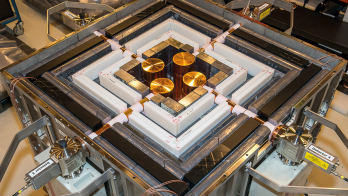
The MiniBooNE experiment at the US Fermilab achieved two major milestones recently, as the tank was filled with the last drops of mineral oil and the first trickle of beam was delivered to the temporary absorber. The MiniBooNE experiment is designed to be a definitive investigation of the Los Alamos LSND experiment’s evidence for anti-muon-neutrino to anti-electron-neutrino oscillations, which is the first accelerator-based evidence for oscillations. The detector consists of a 12 m diameter spherical tank covered on the inside by 1280 phototubes (each 20 cm in diameter) in the detector region and by 240 phototubes in the veto region. The tank is filled with 800 tonnes of pure mineral oil, giving a fiducial volume mass of 440 tonnes. The detector is located 500 m downstream of a new neutrino source that is fed by Fermilab’s 8 GeV proton Booster. A 50 m decay pipe following the beryllium target and magnetic focusing horn allows secondary pions to decay into muon-neutrinos with an average energy of about 1 GeV. By switching the horn polarity, a predominately anti-muon-neutrino beam can be produced. An intermediate absorber can be moved into and out of the beam at a distance of 25 m, allowing a systematic check of the neutrino backgrounds.
The MiniBooNE detector oil fill finished on 3 May, and the detector is now complete and taking data with cosmic rays and laser calibration flasks. The beamline commissioning is under way, with the first beam delivered to the temporary absorber; data-taking with neutrinos will begin this summer after the magnetic focusing horn is installed and the neutrino beamline is completed. With 5 ¥ 1020 protons on target (about a year at design intensity), MiniBooNE will be able to cover the entire LSND allowed region with high sensitivity (>5 sigma). If the LSND oscillation signal is verified, then a second detector (BooNE) will be proposed to be built at the appropriate distance from the neutrino source, which will allow a precision measurement of the oscillation parameters and a search for CP and CPT violation.







